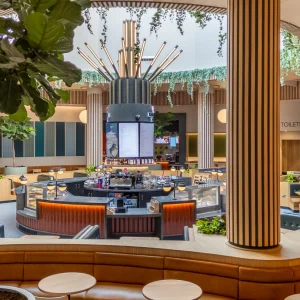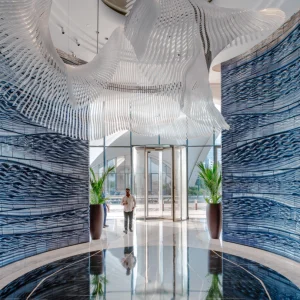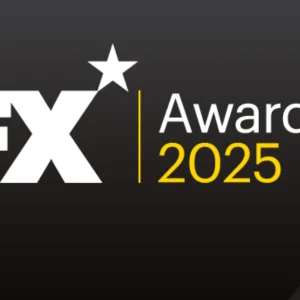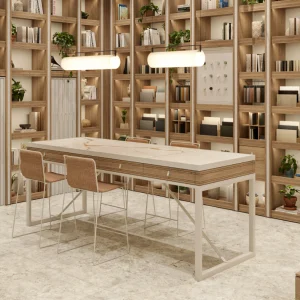THE ART WORLD has changed. Today it is all about art fairs, and biennales, of which there are now so many that each new one threatens to dilute their impact and importance, and overwhelm a collector’s schedule. From Venice founded in 1895, to the Kassel Documenta, the biennale São Paulo, Sharjah and now Istanbul and Singapore, Liverpool, Berlin, Yokohama and Kochi in Kerala, Moscow and Sydney, they are a completely global business.
 Tom Postma Design is responsible for the look of specific areas at Art Basel Miami Beach, such as the info zones and restaurants. Its aim here is to capture the relaxed and distinct atmosphere of the beach. Image Credit: Mark Niedermann
Tom Postma Design is responsible for the look of specific areas at Art Basel Miami Beach, such as the info zones and restaurants. Its aim here is to capture the relaxed and distinct atmosphere of the beach. Image Credit: Mark Niedermann
Frieze fair in London began in 2003. It expanded to New York in 2012. The Frieze franchise now has seven fairs, with four in the US. Last year, it acquired the Armory Show in New York and Expo Chicago. Frieze Seoul is the latest. Then there is Art Basel (spawning offshoots in Miami Beach, Paris and Hong Kong), Art Brussels, and Art Düsseldorf, the Foire Internationale d’Art Contemporain (FIAC) in Paris, and the world’s leading art fair, TEFAF Maastricht, that began life in 1988 as the European Fine Art Fair, that was itself the offspring of two 1970s Netherlandish fairs: Pictura and De Antiquaits International.
 At Art Basel Hong Kong the firm plays a significant role in positioning the prominent art pieces in the Encounters sector. Image Credit: Mark Niedermann
At Art Basel Hong Kong the firm plays a significant role in positioning the prominent art pieces in the Encounters sector. Image Credit: Mark Niedermann
And that’s just for starters. The venerable Grosvenor House Art & Antiques Fair, founded in 1934 folded in 2009 before a new fair, Masterpiece London, rose in its place. A child of the 1960s, Art Cologne is considered to be the oldest contemporary art fair. Tokyo Gendai is organised by the Art Assembly, which runs other fairs all around Asia – Taipei Dangdai, India Art Fair, Photofairs Shanghai and Art SG in Singapore – along with Sydney Contemporary. Thus despite the troubled global economy, London in October was as ever flooded by an acquisitive tribe of hedge fund managers, oligarchs, and movers, sheikhs, and sheikhas thronging Frieze to stock up on investment-grade artworks with a cumulative insurance value of zillions. Name a major city that doesn’t have an art fair now?
 The Di Donna booth at TEFAF, New York. The city still accounts for the bulk of global art sales. Image Credit: Mark Niedermann
The Di Donna booth at TEFAF, New York. The city still accounts for the bulk of global art sales. Image Credit: Mark Niedermann
The proliferation of contemporary fairs since the experimental outing back in 1967 has seen no signs of abating. Art fairs are a necessary part of the gallery business: they drive anywhere from 10–40% of all revenue, according to dealers. If a gallery offers market-friendly material (which usually means attractive paintings), it can pocket more than $500,000 in just a few days (though travel, booth fees and other expenses can easily exceed $100,000). Some small and midsize galleries are working to limit their reliance on fairs. The gallery business can be extremely volatile. In a slow month, a dealer might be uncomfortably in the red; in a busy month, they might accrue enough revenue to cushion them for the rest of the quarter. One sale could make the difference between a good month and a lousy one.
 There are now over 300 art fairs every year. Image Credit: Katrina Krumina
There are now over 300 art fairs every year. Image Credit: Katrina Krumina
However, the art world is very good at giving itself a bad name. Last autumn in Paris, the Wildenstein family was charged with being a criminal enterprise, responsible for operating as the state prosecutor put it, ‘the longest and the most sophisticated tax fraud’ in modern French history. Wildenstein has a billion dollar guillotine hanging over its head, having possibly deprived the French state of hundreds of millions of euros. Typically, their art was held in shell companies and trusts in tax havens, hundreds of paintings including 180 Bonnards for starters – 180! – being held at the Geneva free port, a prison-like complex of high-security storage facilities said to contain more art than the Louvre. Independent of any national jurisdiction, free ports allow traders to ship and store property without paying taxes or customs duties. It has been estimated that $100bn worth of art and collectibles are held in the Geneva free port alone, to say nothing of those in Zurich, Luxembourg, Singapore, Monaco, Delaware or Beijing.
 Paris+ was assisted in 2023 by concurrent exhibitions at the city’s major museums, and this year will be boosted by a move to the refurbished Grand Palais. The city has proved the main beneficiary of the art world’s Brexit blues. Image Credit: Ivan Erofeev
Paris+ was assisted in 2023 by concurrent exhibitions at the city’s major museums, and this year will be boosted by a move to the refurbished Grand Palais. The city has proved the main beneficiary of the art world’s Brexit blues. Image Credit: Ivan Erofeev
The world of art dealers is probably the largest legal, unregulated market. Not subject to the rules that encase banks, dealers are not required to verify customers’ identities, report large cash transactions or flag suspicious activity. The tradition that collectors can insist on anonymity, long framed as genteel discretion, has not budged – just exactly, not rumoured but exactly, who did buy Leonardo da Vinci’s $450.3mn Salvator Mundi? A code of omertà has been the governing principle, the inscrutability of the trade making it a leading conduit for sanction-evading oligarchs and other billionaires looking to launder excess capital. Art fairs dived into this private world and have grown at warp speed for 20 years now. These events have grown so much, compete for the footfall of the rich, and have increasingly come to rely on design to attract the money.
 The flowers at TEFAF Maastricht are a renowned part of the event’s DNA. Image Credit: Tom Postma Design
The flowers at TEFAF Maastricht are a renowned part of the event’s DNA. Image Credit: Tom Postma Design
Now for the positive aspect of all this, the design side. Leading the field by miles is Postma in Amsterdam. Tom Postma studied at the Rietveld Academy and the Rijksakademie in the Netherlands. He worked as an artist for 20 years, mainly producing monumental sculptures for parks, but having become increasingly interested in architecture and design, he made a choice: to move from the independent life of an artist to the collaborative life of a designer. His first big assignment was an art show for the Palazzo Fondazione Levi on the Grand Canal during the Venice Biennale. It proved a good advert for his obvious understanding and appreciation of art together with his sensitive design capabilities. He began by designing galleries, before TEFAF, then quite a small business, asked him to work with it. And as it he grew so did Tom Postma Design. Today the firm numbers 75 galleries among its clients, 17 art fairs, 35 museums, foundations and institutions, along with a world-class list of retailers from Georg Jensen to Lowe and specialist clients such as the ABN AMRO World Tennis Tournament. It is a special kind of design business for a special kind of client. TEFAF is now the most spectacular art fair going – there is nothing more elaborate.
 The flowers at TEFAF Maastricht are a renowned part of the event’s DNA. Image Credit: Tom Postma Design
The flowers at TEFAF Maastricht are a renowned part of the event’s DNA. Image Credit: Tom Postma Design
Designing a major art fair is like creating a small town, a temporary but real one: a place with corridors and streets and squares, special exhibitions, blocks of galleries, VIP lounges, restaurants and cafes, meeting rooms, conference halls, video-conference facilities, entrances and exits. It has to have a pleasant flow, a clear beginning and end, and get visitors to that gallery located in a corner, far, far away from the main action. Sightlines are all important, as is how you enter a gallery space, what you see, how the most important pieces are displayed, the viewing lines, the through lines, the rhythm. There is a floor plan and a grid, and by making places to pause and reflect, to rest, and take a drink, the designer has to manipulate the crowds in subtle ways to get them to visit it all. Most important is the lighting: there is nothing worse than a good painting or a piece of sculpture badly lit.
 Maarten Willemstein. Image Credit: Mark Niedermann
Maarten Willemstein. Image Credit: Mark Niedermann
The logistics can be an event manager’s nightmare. The three-week timeframe to turn an empty space into one of the most extraordinary spectacles is a very specialised art form, a logistical jigsaw puzzle of epic proportions. The time-related location of resources to meet user requirements is concerned with one specific event: a show, event logistics being quite unlike the ongoing activity of running a business. The supply, movement, installation and removal of products and services; balancing the exhibitors, their own designers, suppliers and designated contractors, the end client and the sponsors; trying to manage everyone in an extremely high-pressure environment inevitably means only a very few can cope. Everyone may well be working towards the same objective, to be ready to open on time, but that is easier to say than to deliver, especially when each team of contractors is making sure to stick to their own timetable. Scheduling and site planning are key, as are negotiations around delivery times, access points, equipment, safety plans and removal times – there is by definition no possibility of a dry run: this is a one-take wonder – every time. On top of which there is the question of security, of paramount importance when the value of art on each individual stand can top several millions, in some cases hundreds of millions. It is a little like directing a play, scene by scene, and involves months of research, imagining and planning; weeks and weeks of building; and, above all, it requires a singular vision: to bring hundreds of presenters and thousands of attendees together on a certain date.
 The design seen here is part of a series of organic shapes at TEFAF Maastricht. At the entrance (seen on page 84), the shapes cascaded over the walls, the idea being to create the feeling that nature was growing over the architecture. Image Credit: Tom Postma Design / Photo By Mark Niedermann
The design seen here is part of a series of organic shapes at TEFAF Maastricht. At the entrance (seen on page 84), the shapes cascaded over the walls, the idea being to create the feeling that nature was growing over the architecture. Image Credit: Tom Postma Design / Photo By Mark Niedermann
It is the creation of an experience from the entrance to the flower arrangements, inventive lighting to gallery booths for tenants ranging from ancient to contemporary, and including antiques and jewellery. With the Netherlands being the world’s largest exporter of flowers, particularly at events like TEFAF in Maastricht, people expect to see flowers, everywhere. This is flower country. You can surely have a lot of fun but you really have to know what you are doing. Translating art into architecture, to building a city of art, and ensuring that there is an overall visual marvel for attendees to look forward to is no mean feat. There needs to be an overall vision of the event, not just a place to buy art. And those attendees are likely to be the most visually aware audience you will ever get to see. Designing in service to art, to individual galleries and dealers, while also creating spectacular design elements where there is no art on show in the public areas, is a real challenge. You need a critical eye together with active control of everything, and an ability to adapt to circumstances as revisions become a requirement in real time. And when the Royals and television crews and the public have all gone home, you get to do the whole process in reverse, strike the set and move on.
The architecture of the fairs and their programming has become significantly developed over the past couple of decades, and the ambiance of the places where people buy art, such as the galleries and the art fairs, has become significantly more important than it once was, certainly since 1988 when Postma founded his business. Delivering great events is not for the faint-hearted. Every time you have to tell a new story, every time it is effectively a yearround project, produced by art lovers for art lovers, creating a new DNA for each exhibition, an overall identity frequently with an updated version for its next edition, working within temporary structures and existing buildings, to ensure every exhibitor is made to feel special, and a part of a very rewarding experience.
 For TEFAF New York Tom Postma Design opts for a contemporary white backdrop. Image Credit: Tom Postma Design / Photo By Mark Niedermann
For TEFAF New York Tom Postma Design opts for a contemporary white backdrop. Image Credit: Tom Postma Design / Photo By Mark Niedermann
It may appear to be something like the industrialisation of the art world, the hypercommercialisation of art, but it is big business. The numbers of people visiting galleries and museums worldwide is still significantly below the numbers seen at the turn of the century. The global art business is improving but, despite appearances, it is certainly not booming. Under the bubbly mix on view at the shows, it is definitely cooling. Changes have been seismic and galleries have had to reset. Given the challenges, they have had to adapt in recent years to the shortfall in footfall to traditional brick-and-mortar spaces as all of them seek to discover the next big thing. Shifts in visitor numbers, none of them are prepared to discuss, is such a touchy subject. The energy shifts from one city to another, galleries working hard to keep up, and trying to appear on to be on top of things. There will always be sky-high prices for the few, but when sales by the four major auction houses fell 16% in the first half of 2023 compared to the previous year, the writing was on the wall. And the two big art fair franchises that hold events in four different cities every year have not regained the market share they had pre-pandemic. Nevertheless fairs have become critical to gallery business. Location is everything – and branding. China is down as a market for art, and London suffered seriously from the costs and consequences of the UK’s exiting the EU in 2016. Paris is doing very nicely, thank you. Paris+ by Art Basel was ably assisted in 2023 by an array of concurrent exhibitions at the major museums in the city, and this year will be boosted by its move to the grandiose refurbished Grand Palais. Added to which the allure of the city means it is back to being at the heart of the art world. New York still accounts for the bulk of global art sales – London was always in second place by sales, but that is fast disappearing. Paris has proved the main beneficiary of the art world’s Brexit blues. The arrival in Regent’s Park of a marquee full of the world’s best contemporary art – along with artists, dealers and a parade of wealthy collectors – seized London by the scruff of its grimy neck in 2003. And galleries from New York, LA, Berlin, Paris, Antwerp, Moscow and Mexico City all set up stands underneath the huge temporary structure, designed by one David Adjaye; it’s all a long, long time ago. Tate Modern had opened and smashed all expectations, so this was a gamble worth taking: it worked. It revolutionised London’s art world. Now, the internationalisation of the business is proof, if proof were needed, that to stay ahead Frieze has had to change.
The art market is working hard to dodge the obstacles that came at it – Covid, inflation, austerity-bashed economies, soaring interest rates, and international conflicts all exposed its frailties. People are rearranging their priorities. Gone are the days when collectors would increasingly cite financial value as their main motivation for buying pieces. And so inevitably missing are young, very wealthy, very excited entrepreneurs who had been able to borrow at historically low interest rates and buy artworks with the cash. Buying art with borrowed money, when the value of the art is going up, was just painless. Lurid stories about art-as-merchandise merchants will never disappear from tabloid papers, but as love and enjoyment of art has become the fashion everywhere, the way such people shop has changed forever.
Most collectors appear to prefer to attend art fairs over individual gallery spaces, and collaborations, beyond the fairs, appears to be a central point of focus and development. Thus Frieze scooped up the Armory show for $24.4m in 2023. Like Art Basel and the other major businesses, it is expanding its empire across the world, a world of chic and glamour, and high rollers. These have been uncertain times as the art world has had to adapt to a new normal post-Covid, but a cocktail of energy and seasoned talent has created wonders. Fostering community and collector engagement have been essential to ensuring a gallery gets visitors. Fairs are the heart of that resilience amid an ever-changing new normal. There are now over 300 art fairs every year, and the model provides a venue for commercial and social exchange between galleries, collectors, and art professionals. Into this world there have been new approaches to the model in recent years as cities carve out alternative fairs: non-fair fairs, social clubs, but what unites them all is providing different points of access for viewing art and socialising, alongside creating an environment where the younger, smaller galleries feel able to make an appearance and take risks. And there are always offshoots, like the club built within a disused mayonnaise factory minutes from the Art Basel Messeplatz in 2023.
Constantly breathing fresh air into this world is quite a skill. No one has done it better and more often than Tom Postma. His shows have become immersive, spellbinding and unforgettable, people being evermore driven by brand. Creating those brands has become so important as those brands have become bigger than their business and a rare opportunity for growth. The fairs have a duty to deliver clients to the galleries, and a responsibility to deliver the great collectors and institutions of the world to their booths. That is an art form in itself. That is the business that Tom Postma Design is in.





